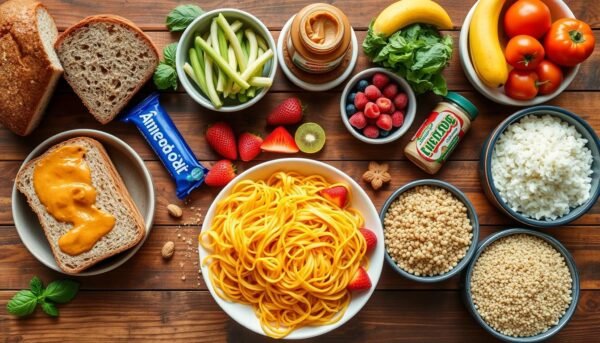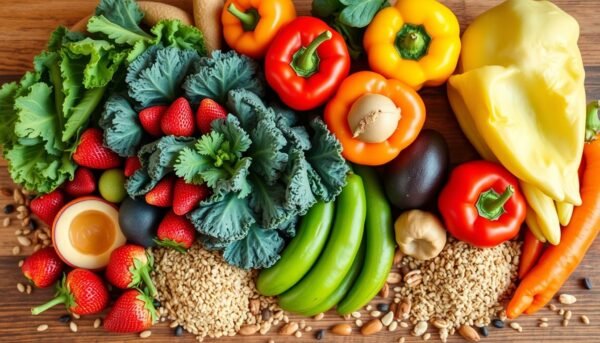As I stood on the scale, watching the numbers climb, I knew I had to change. The extra weight had been creeping up for years. I wanted to feel confident, energetic, and healthy.
But the path to getting there seemed daunting. That is, until I found a sustainable way to lose weight. It has helped many people like me reclaim their wellbeing.
In the next few pages, I’ll share tips and strategies for losing weight. Whether you want to lose a few pounds or make a big change, this guide has you covered. Get ready to take control of your health and live a vibrant, fulfilling life.
Getting Started: Assessing Your Weight Loss Readiness

Before starting your weight loss journey, take a moment to check if you’re ready. This means looking at your mental state, setting goals, and knowing where you start.
Mental Preparation Checklist
For lasting weight loss, you need a new mindset and lifestyle. Think about why you want to lose weight. Is it for a good reason, or just to see a number drop?
Also, consider how you handle stress. Stress can make you eat more and slow down your progress.
Setting Realistic Weight Loss Goals
It’s key to set goals you can reach. Aim to lose 1-2 pounds a week, as experts suggest. Have both action goals, like “Walk 30 minutes daily,” and outcome goals, like “Lose 10 pounds in 2 months.”
Remember, slow and steady is best for losing weight.
Tracking Your Starting Point
First, take baseline measurements. Note your weight, body measurements, and health numbers like blood pressure. This will be your starting point to track your progress.
| Baseline Measurements | Current Values |
|---|---|
| Weight | 205 lbs |
| Body Mass Index (BMI) | 30.1 |
| Waist Circumference | 40 inches |
| Blood Pressure | 130/85 mmHg |
| Cholesterol (Total) | 200 mg/dL |
By checking your readiness, setting goals, and knowing your start, you’re ready for a successful weight loss journey. Be patient, keep going, and make lasting lifestyle changes.
Creating Your Sustainable Calorie Deficit Plan

For lasting weight loss, aim for a calorie deficit. This means burning more calories than you eat. Aiming for 500 to 750 calories less each day can help you lose 1 to 2 pounds weekly. This slow pace is better than trying to cut calories too much, which can be hard to keep up.
Choose foods that are full of nutrients but low in calories, like fruits, veggies, and whole grains. Add lean proteins, healthy fats, and fiber to your meals. This will keep you full and happy. Planning your meals for the week is key. Make sure your diet is balanced and you eat the right amounts.
Using smaller plates can help you eat less. It’s a simple trick to cut down on calories. With some planning, you can make a calorie deficit plan that works well for a long time.
| Food Group | Recommended Servings | Calorie Range |
|---|---|---|
| Fruits | 1-2 servings per day | 60-120 calories per 6-oz serving |
| Vegetables | 2-3 servings per day | 25-50 calories per 1-cup serving |
| Lean Proteins | 3-4 servings per day | 100-200 calories per 3-oz serving |
| Whole Grains | 3-4 servings per day | 150-200 calories per 1-cup serving |
| Healthy Fats | 2-3 servings per day | 45-90 calories per 1-tbsp serving |
The secret to calorie deficit, sustainable weight loss, and good meal planning is balance. It also takes patience and a full view of your health and happiness.
Essential Losing Weight Tips for Long-Term Success

For lasting weight loss, you need a plan that covers diet and lifestyle. Use portion control, time your meals right, and swap foods wisely. These steps will help you succeed in your weight loss journey.
Portion Control Strategies
Controlling your portions is key to losing weight. Use smaller plates, measure your food, and watch high-calorie items. Losing 5% of your weight can lower your risk of serious diseases like heart disease and diabetes.
Meal Timing Techniques
When you eat matters for weight loss. Eat slowly, chew well, and space out your meals. Eating a big breakfast and a small dinner can help you lose weight better than the other way around.
Smart Food Swaps
Choosing the right foods is vital for lasting weight loss. Swap sugary drinks for water or unsweetened options. Pick whole grains over refined ones and lean proteins over fatty meats. Adding more fruits and veggies to your diet gives you fiber, vitamins, and minerals without too many calories.
| Food Swap | Healthier Option | Potential Benefit |
|---|---|---|
| White bread | Whole grain bread | Higher in fiber and nutrients, can help with satiety |
| Soda | Unsweetened sparkling water | Eliminates added sugars, which can contribute to weight gain |
| Fried chicken | Grilled or baked chicken | Reduces unhealthy fats and calories, while maintaining protein intake |
By following these essential tips, you’ll be on your way to lasting success in your health and wellness journey.
Building a Nutrient-Rich Diet Foundation

Starting a weight loss journey needs careful thought about what you eat. Eating foods rich in nutrients helps your body and supports losing weight. Studies show that whole grains are good for your heart and help with weight.
Fruits and vegetables are also key. They can lower the risk of serious diseases like heart disease and cancer.
At the heart of a good diet are foods full of vitamins, minerals, and fiber. This includes colorful fruits and veggies, whole grains, lean proteins, and healthy fats. Foods like salmon, rich in omega-3s, are great for your heart.
The Dietary Guidelines for Americans suggest a balanced plate. It should have fruits, veggies, whole grains, proteins, and dairy or soy. This way, you feed your body well and help with weight loss.
Changing to a balanced diet means making smart, thoughtful choices. It’s about eating foods you like in small amounts, like a glass of wine or a bit of ice cream. This helps you stick to a healthy diet for the long term.
Achieving a Balanced Diet
To start a nutrient-rich diet, try these tips:
- Aim for at least four servings of vegetables and three servings of fruits daily.
- Choose whole grains, such as brown rice, quinoa, and whole wheat bread, over refined options.
- Incorporate lean protein sources, such as grilled chicken, fish, legumes, and tofu, into your meals.
- Include healthy fats, like those found in avocados, nuts, and olive oil, to support nutrient absorption and satiety.
- Limit added sugars, processed foods, and saturated fats to maintain a balanced diet.
- Stay hydrated by drinking plenty of water throughout the day.
By focusing on nutrient-dense foods and making smart choices, you can build a diet that helps with weight loss and health. Remember, getting healthier is a slow journey. Be patient and celebrate your small wins.
| Food Group | Recommended Servings | Examples |
|---|---|---|
| Vegetables | At least 4 servings per day | Spinach, broccoli, carrots, bell peppers, tomatoes |
| Fruits | At least 3 servings per day | Apples, bananas, berries, oranges, kiwi |
| Whole Grains | At least 3 servings per day | Brown rice, quinoa, whole wheat bread, oats |
| Lean Proteins | At least 2 servings per day | Grilled chicken, fish, lentils, tofu |
| Healthy Fats | In moderation | Avocado, nuts, olive oil, fatty fish |
Strategic Exercise Routines for Maximum Fat Burning

To lose weight and burn fat, mix cardio and strength training. Do at least 150 minutes of moderate cardio or 75 minutes of vigorous cardio weekly. Good cardio options include brisk walking, jogging, cycling, or swimming.
Also, do strength training twice a week to build muscle and boost metabolism. Focus on big exercises like squats, deadlifts, and bench presses. Increase the weight or intensity over time to keep challenging your muscles and losing fat.
Cardio Workouts for Weight Loss
Cardio is key for burning calories and using fat. Mix low-intensity steady-state (LISS) and high-intensity interval training (HIIT) in your routine. LISS, like brisk walking or swimming, helps keep muscle while losing fat. HIIT, like sprints or cycling intervals, boosts your metabolism and calorie burn.
Strength Training Benefits
Strength training is vital for losing weight and burning fat. Muscle burns more energy than fat, so more muscle means a higher metabolism. Big exercises like squats, deadlifts, and bench presses are great for fat loss.
Recovery and Rest Days
Rest and recovery are crucial for your workout routine. Have at least one or two rest days a week to repair and rebuild muscle. Use these days for light activity like walking or gentle stretching. Good sleep and stress management also help with fat burning.
| Day | Workout |
|---|---|
| 1 | Barbell deadlifts, kettlebell goblet squats, dumbbell bench press, renegade rows, and kettlebell swings |
| 2 | 20 minutes of high-intensity intervals, followed by 30 minutes of steady-state cardio on a preferred machine |
| 3 | Barbell squats, dumbbell overhead press, kettlebell lunges, and barbell bent-over rows |
| 4 | 40-minute session of steady-state intervals combining moderate and high-intensity efforts on a cardio machine |
Stay consistent with your workouts and keep a calorie deficit in your diet for fat loss. As you get fitter, increase the intensity and duration of your workouts. This will keep challenging your body and help you burn more fat.
The Role of Sleep and Stress Management

Quality sleep and managing stress are key for losing weight. Research shows that bad sleep and stress can hurt our weight loss efforts. They can make it hard to keep a healthy lifestyle.
Not sleeping well messes with our hunger hormones. Sleep-deprived people often feel hungrier because of more ghrelin and less leptin. This can make us eat more and gain weight.
Also, not enough sleep can cause metabolic problems. This includes insulin resistance and a slower metabolism. Studies show that adults sleeping less than 6 hours a night are more likely to be obese.
Managing stress is also important for losing weight. Stress can make us crave high-calorie foods. It can also weaken our immune system and cause health problems.
- Try to sleep at least 7 hours each night.
- Have a calming bedtime routine, like stretching, reading, or meditation.
- Stay away from screens and blue light before bed.
- Do yoga, deep breathing, or mindfulness meditation daily.
By focusing on sleep quality and stress reduction, you can help your weight loss. You’ll also feel better overall.
Mindful Eating Practices and Behavior Modification

Long-term weight loss isn’t just about counting calories. It’s about having a healthy relationship with food. Mindful eating helps us listen to our body and make better choices.
Identifying Emotional Eating Triggers
Understanding emotional eating is key in mindful eating. Emotional eating can stop us from losing weight. By keeping a food diary, we can find out what makes us eat emotionally.
Once we know our triggers, we can find other ways to cope. This way, we don’t turn to food for comfort.
Building Healthy Eating Habits
- Eat slowly and enjoy each bite, noticing the flavors and textures.
- Don’t eat while watching TV or on your phone.
- Stop eating when you’re full, not when the plate is clean.
- Plan meals and cook healthy foods at home.
- Use exercise or meditation to handle stress, not food.
By practicing mindful eating and building healthy habits, we can improve our relationship with food. This supports our weight loss goals and overall health.
Hydration and Metabolism Boosters

Drinking enough water is key for losing weight. Men should drink 15.5 cups (3.7 L) of water a day. Women should aim for 11.5 cups (2.7 L).
Drinking water before meals can help you eat less. It also makes you feel full. Try to drink water instead of sugary drinks to stay hydrated.
To speed up your metabolism, eat foods that help. Green tea, spicy peppers, and lean proteins are good choices. Drinking 500 milliliters of water can also help burn fat.
HIIT workouts can boost your metabolism after exercise. This is especially true for young, fit people.
- Drink at least 8 cups (64 ounces) of water daily to support hydration and weight loss.
- Replace high-calorie beverages with water, unsweetened tea, or other low-calorie options.
- Incorporate metabolism-boosting foods like green tea, chili peppers, and lean proteins into your diet.
- Engage in HIIT workouts to increase post-exercise calorie burn and metabolic rate.
| Nutrient or Activity | Impact on Metabolism |
|---|---|
| Protein | Requires 20-30% of its usable energy to be expended for metabolism, compared to 5-10% for carbs and 0-3% for fats. |
| Caffeine (from coffee) | Can increase metabolism, with varying effects based on activity levels. |
| Green tea and oolong tea | May indirectly help prevent a weight loss plateau by affecting fat breakdown. |
| Capsaicin (from chili peppers) | Can burn around 10 additional calories per meal, potentially leading to 1 pound (0.5 kilograms) of weight loss over 6.5 years. |
| Lack of sleep | Linked to an increased chance of obesity and may slightly decrease how the body metabolizes fat. |
Stay hydrated, eat metabolism-boosting foods, and get enough sleep. These habits will help you lose weight and stay healthy.
Tracking Progress and Adjusting Your Strategy
Starting your weight loss journey? It’s key to track your progress regularly. This helps you see if you’re on the right path. You can use your weight, body measurements, and photos to understand what works and what doesn’t.
Weekly Measurement Methods
Step on the scale every week, at the same time, like in the morning. Use a scale you trust. Also, measure your waist, hips, and thighs to see how your body changes. Remember, the scale number is just one part of the story. How your clothes fit and how you feel are important too.
Progress Photo Documentation
Take photos of yourself in the same lighting and clothes. These pictures can really motivate you, even when the scale doesn’t show big changes. Celebrate small wins like more energy, better sleep, and feeling good overall.
As you track your progress, be ready to change your plan if needed. If you hit a plateau, try something new with your diet or workouts. Talk to a dietitian or doctor to make sure you’re making good changes. With determination and flexibility, you’ll reach your weight loss goals.
This post may contain affiliate links which means I may receive a commission for purchases made through links. I will only recommend products that I have personally used! Learn more on my Private Policy page.